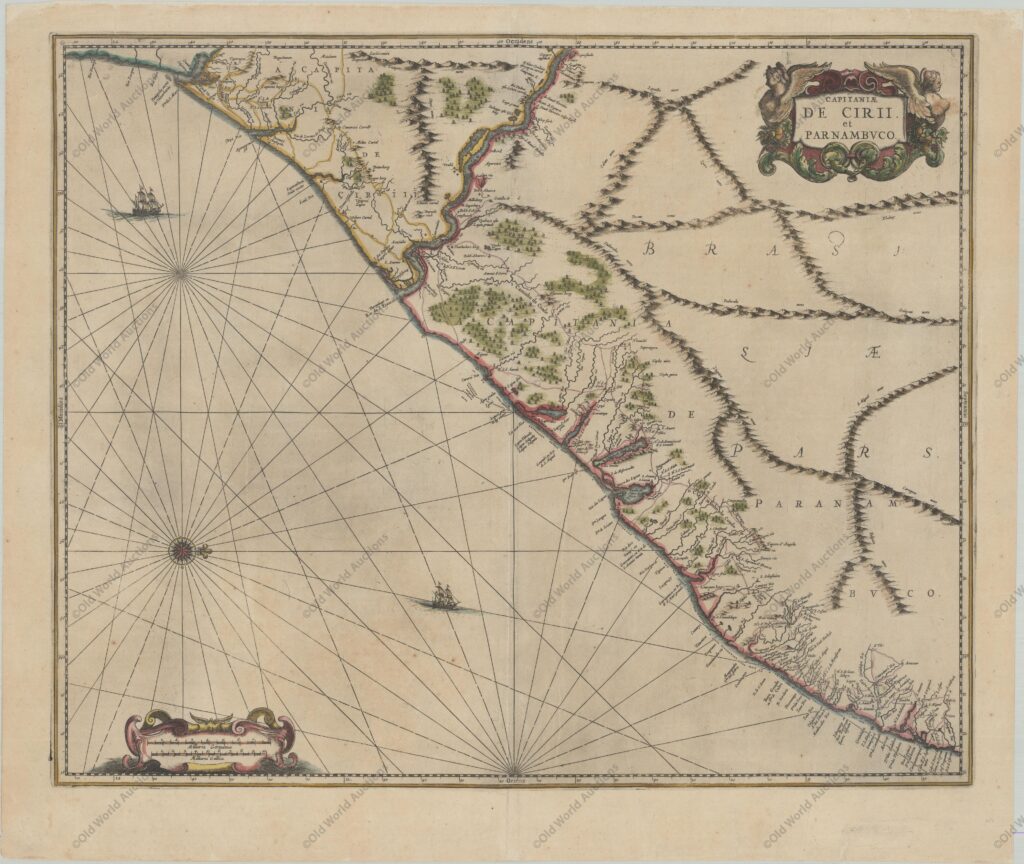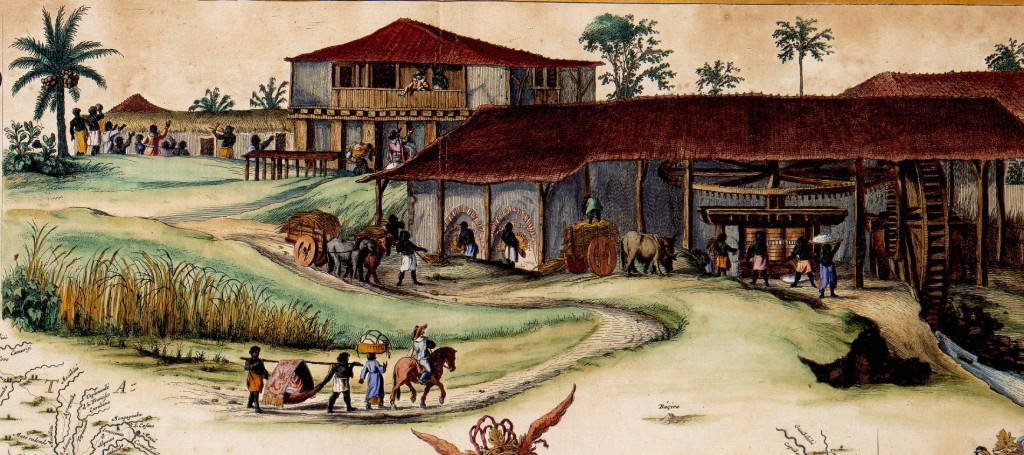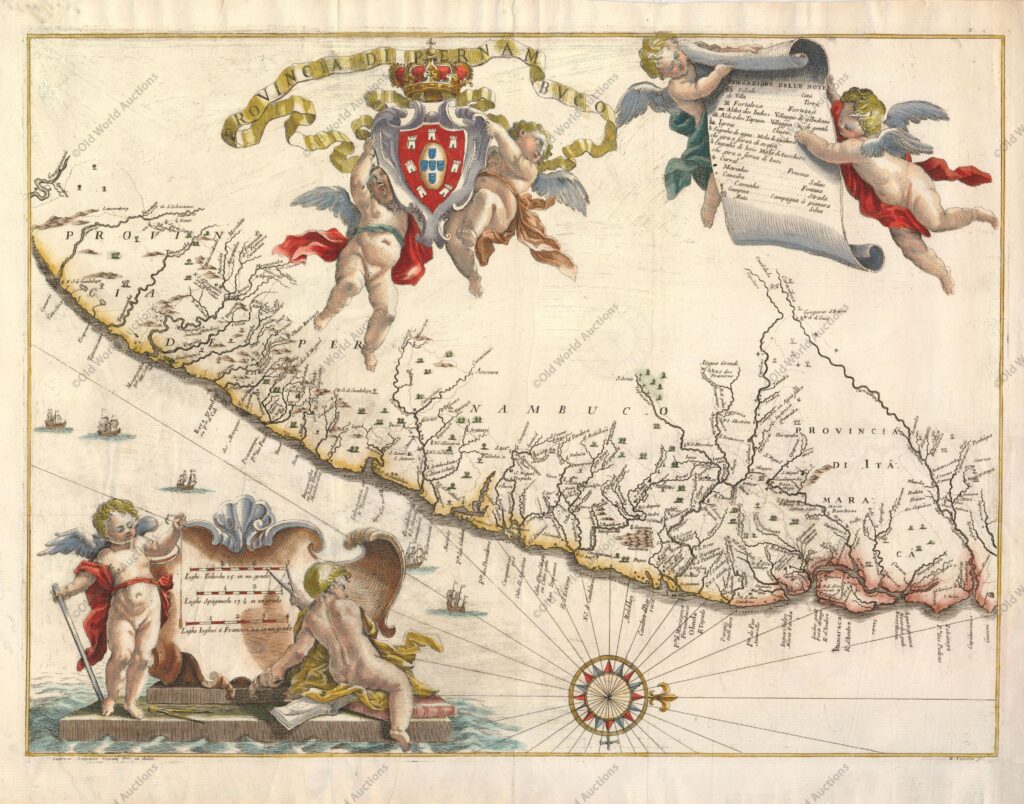Discover the fascinating history of sugar cane, from its origins in Papua New Guinea, its introduction to the Algarve and its expansion to Madeira and Brazil. Learn how sugar cultivation fuelled the colonial development and economy of Pernambuco in the 16th century.
Sugar cane, which originated in Papua New Guinea, was cultivated in South Asia and brought by the Arabs to Sicily and later to Spain.
In Portugal, its cultivation began in the Algarve during the reign of King João I and was extended to the island of Madeira by Prince Henry the Navigator. Cultivation on Madeira developed rapidly and by 1455 it was producing 6,000 arrobas of sugar.
The cultivation of sugar was officially introduced to Brazil in 1532 by Martim Afonso de Souza, but it had already existed in Pernambuco since the days of Cristóvão Jacques‘s trading post in Itamaracá.
The Captaincy of Pernambuco, granted to Duarte Coelho Pereira in 1534, prospered with the help of Jewish capital and African slave labour. The first sugar mill was built in Beberibe.
Sugar was the main driving force of Pernambuco’s economy, which expanded to other captaincies and participated in the incorporation of territories such as Maranhão.

The Journey of the Sugarcane: From Portugal to colonial Brazil
Sugarcane originated in distant Papua (New Guinea), where it was already known some 12,000 years ago, and was later cultivated in South Asia when the Arabs brought Sugarcane (Saccharum officinarum L.) from Africa to Sicily and from there to the south coast of Spain.
Among the Portuguese, the cultivation of sugar cane began in the Algarve during the reign of King João I (1404), and was later brought to the Island of Madeira by Prince Henry the Navigator, where it became one of the main engines of progress in the colonial world of the time.
From a product sold in European apothecaries in the 14th century, as part of the Arabic cuisine that dominated the Iberian Peninsula for three centuries and tried to develop sugar cane plantations in Granada, sugar arrived in Portugal “as a medicine and a treat, reserved for rich people”.
The first sugar cane seedlings were planted on the island of Madeira in 1425, brought from Sicily by Prince Henry the Navigator and planted in the centre of Funchal, near Terreiro da Sé.

História do engenho de açúcar no Brasil Colonial
The cultivation of sugar cane soon developed, and in 1455 production was estimated at 6,000 arrobas.
In 1498, two years before the discovery of Brazil, Dom Manuel, king of Portugal, had already set the export from the islands – Madeira, the Azores, São Tomé and Cape Verde – at 120,000 arrobas.
By the end of the 15th century, Portuguese confectionery was already centuries old, with its honey cakes, alfenim, alféloa, originating from Arab cuisine.
It dates back to the time when the Cortes of Évora took action against the alfeloeiras who, among other things, “made children cry and ask their parents for more money to buy the said alféloa”; hence the ban by Dom Manuel, punishable by imprisonment and flogging, on the trade in this sweet, which was carried out by men.
By this time, the sugar produced on the island of Madeira was well known in Europe.
The story goes that Captain Simão Gonçalves da Câmara, a Madeiran known for his liberalism, sent Pope Leo X (1513-1521) a life-size sculpture of all the cardinals of the Sacred College as a present.
Although it was officially introduced to Brazil by Martin Afonso de Souza in 1532, Sugar cane had already dominated the landscape of Pernambuco since the early days of colonisation, even at the time of Cristóvão Jacques’s trading post on the Itamaracá Canal (1516).
In 1526, the payment of duties on sugar from Pernambuco was already mentioned in the Lisbon Customs House, according to information first revealed by F. A. Varnhagen.
When the system of hereditary captaincies was established in Brazil, the territory of the Captaincy of Pernambuco was donated to Duarte Coelho Pereira, who had rendered important services to the Crown in the conquest of the Indies.
The territory that made up the original Captaincy of Pernambuco was established when King João III donated it to Duarte Coelho Pereira on 10 March 1534.
The southern half of the Itamaracá canal – which King João III called the Santa Cruz “river” – up to fifty paces beyond the site of the original Cristóvão Jacques trading post, marked the northern boundary of Pernambuco; to the south, the limit of the captaincy was the São Francisco River, in all its breadth and extension, including all its islands from its mouth to its source.
Thus the territory of the Captaincy of Pernambuco turned southwest, following the course of the river to its sources in the present State of Minas Gerais.
To the north, the king drew a line westwards through the country to the limits of his conquest, which were defined by the Treaty of Tordesillas (1493) as the lands beyond 370 leagues west of the Cape Verde Islands.
This roughly defined the boundaries of the Captaincy of Duartina, whose sixty leagues of frontier covered the whole of what is now the State of Alagoas and ended to the south, at the São Francisco River, on the border of what is now the State of Minas Gerais.
Thanks to the possession of this important waterway, in all its length and breadth, the territory of Pernambuco expanded in a south-westerly direction, far beyond the sixty leagues stipulated in the Letter of Grant.
According to F. A. Varnhagen, Duarte Coelho’s captaincy had twelve thousand square leagues, making it the largest of all the territories granted by João III.
Arriving in Pernambuco on 9 March 1535, Duarte Coelho was accompanied by his wife, Brites de Albuquerque, his brother-in-law, Jerônimo de Albuquerque, and some families from the north of Portugal who had come to try their luck at developing the sugar cane agro-industry.

It was this “founder of the nation” who systematically laid the foundations of the sugar agro-industry. He brought in new sugar-making techniques with the arrival of mills and specialised craftsmen from the island of Madeira and, above all, the import of Jewish capital to finance the enterprise.
The first sugar mill in Pernambuco, Engenho Velho de Beberibe, was built in the early years of colonisation by Jerônimo de Albuquerque, under the invocation of Nossa Senhora da Ajuda.
It was this enterprise, the first of hundreds that followed, that launched an economy based on sugar cane, founded by the grantee Duarte Coelho, who sent for sugar masters on the island of Madeira, importing slave labour from Africa, where the first blacks came from Guinea.
The cultivation of sugar cane brought new colours, customs, smells and tastes to the landscape, contributing to the development and superpower of the land of Pernambuco, whose beginnings were seen in this way by Oliveira Lima:
The captaincy of Duarte Coelho was the first to flourish, albeit at the cost of much expense and effort, because, in addition to the unusual personal qualities of the grantee, the land praised itself for its excellence. The climate was hot, but tempered by the gentle turns of land and sea so often spoken of by Piso, Maurício de Nassau’s wise physician. Abundant and regular rainfall throughout the hinterland, refreshing the fields, thickening the rivers and preventing droughts. The terrain is not too hilly, descending gradually from the plateaus or tablelands of the interior to the deciduous forests, where beauty is not outweighed by vigour, to the fertile floodplains, bathed by many rivers, and ending in the mangroves or marshes of the sea.
In Pernambuco, the “terra garanhona do massapê“, to use the expression of Gilberto Freyre, was the ideal soil for the foundation of this culture, which has dominated the economy of an entire region for more than four centuries.
With its mills scattered along the floodplains of the Capibaribe, Beberibe, Jaboatão and Una rivers, the Captaincy of Duartina saw the flourishing of the sugar civilisation.

For the first grantor, Nova Lusitânia, as he insisted on calling Pernambuco, would never be a simple mining colony, as the Lisbon orders wanted in the first half of the 16th century, but a land of plantations, the embryo of what would become the civilisation of sugar.
This product was the economic backbone of the great civilising march of Pernambuco, responsible for the colonisation of all of Northern Brazil.
Sugar was the great economic engine of these conquests; sugar, which in 1583 was produced by 66 mills.
The economic situation of the captaincy at the beginning of the 17th century was, in the words of Friar Vicente do Salvador (c. 1564 – c. 1636-39), one of the best, with the busiest port in Brazil and an income of twenty thousand cruzados, “apart from Brazilwood and sugar duties”.
Thanks to the profits from sugar, the people of Pernambuco colonised Paraíba and Rio Grande do Norte, extended its conquest to Ceará and Pará, and played a decisive role in the incorporation of Maranhão into the national territory.
For his part in the effort to incorporate Maranhão, whose territory was occupied by the French, a Pernambucan proudly added this toponym to his surname, a practice that was extended to all his descendants.
I’m referring to Jerônimo de Albuquerque, born in Olinda in 1548, son of Captain Jerônimo de Albuquerque, brother-in-law of the first grantee, with D. Maria do Espírito Santo, an Indian of the Tabaiares tribe, conquered Maranhão from the French, then commanded by Monsieur de la Ravardière, Daniel de la Touche.
By signing the capitulation on 2 November 1615, Jerônimo de Albuquerque added the name of Maranhão to his name.
The history of sugar cane in the colonisation of Brazil – The Sugar Cane Journey: From Portugal to colonial Brazil
Publicações Relacionadas
History of the Captaincy of Todos os Santos Bay between 1500 and 1697
Installation of the General Government in Brazil and foundation of Salvador
Portuguese maritime expansion and the conquest of Brazil
The occupation of the African coast and Vasco da Gama's expedition
Monoculture, Slave Labour and Latifundia in Colonial Brazil
Independence of Brazil - breaking of colonial ties in Brazil
Establishment of the Portuguese colony in Brazil
Carlos Julião: The Military Engineer and Draughtsman Who Portrayed Colonial Brazil
Transfer of the Portuguese court to colonial Brazil
Pedro Álvares Cabral's expedition and the conquest of Brazil
History of the sugar mills of Pernambuco - Beginning and end
Portuguese Empire in Brazil - Portuguese Royal Family in Brazil
Pre-colonial Brazil - The forgotten years
The Origin of Sugarcane and Sugar Mills in Colonial Brazil
Learn about the periods of Brazil's colonial history
Foundation of the city of São Paulo and the Bandeirantes
The History of the Jews in Colonial Brazil
Dutch Invasion of Salvador in 1624: Overview
This post is also on:
![]() Português
Português ![]() English
English ![]() Deutsch
Deutsch ![]() Español
Español ![]() Français
Français



















